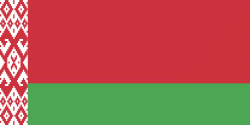Belarusian language
Belarusian (беларуская мова, ) is an East Slavic language. It is the native language of many Belarusians and one of the two official state languages in Belarus. Additionally, it is spoken in some parts of Russia, Lithuania, Latvia, Poland, and Ukraine by Belarusian minorities in those countries.
Before Belarus gained independence in 1991, the language was only known in English as Byelorussian or Belorussian, the compound term retaining the English-language name for the Russian language in its second part, or alternatively as White Russian. Following independence, it became known as Belarusan and since 1995 as Belarusian in English.
As one of the East Slavic languages, Belarusian shares many grammatical and lexical features with other members of the group. To some extent, Russian, Rusyn, Ukrainian, and Belarusian retain a degree of mutual intelligibility. Its predecessor stage is known in Western academia as Ruthenian (14th to 17th centuries), in turn descended from what is referred to in modern linguistics as Old East Slavic (10th to 13th centuries).
In the first Belarus Census of 1999, the Belarusian language was declared as a "language spoken at home" by about 3,686,000 Belarusian citizens (36.7% of the population). About 6,984,000 (85.6%) of Belarusians declared it their "mother tongue". Other sources, such as Ethnologue, put the figure at approximately 2.5 million active speakers. According to a study done by the Belarusian government in 2009, 72% of Belarusians speak Russian at home, while Belarusian is actively used by only 11.9% of Belarusians (others speak a mixture of Russian and Belarusian, known as Trasianka). Approximately 29.4% of Belarusians can write, speak, and read Belarusian, while 52.5% can only read and speak it. In the UNESCO Atlas of the World's Languages in Danger, the Belarusian language is stated to be vulnerable.
There are a number of names under which the Belarusian language has been known, both contemporary and historical. Some of the most dissimilar are from the Old Belarusian period.
Before Belarus gained independence in 1991, the language was only known in English as Byelorussian or Belorussian, the compound term retaining the English-language name for the Russian language in its second part, or alternatively as White Russian. Following independence, it became known as Belarusan and since 1995 as Belarusian in English.
As one of the East Slavic languages, Belarusian shares many grammatical and lexical features with other members of the group. To some extent, Russian, Rusyn, Ukrainian, and Belarusian retain a degree of mutual intelligibility. Its predecessor stage is known in Western academia as Ruthenian (14th to 17th centuries), in turn descended from what is referred to in modern linguistics as Old East Slavic (10th to 13th centuries).
In the first Belarus Census of 1999, the Belarusian language was declared as a "language spoken at home" by about 3,686,000 Belarusian citizens (36.7% of the population). About 6,984,000 (85.6%) of Belarusians declared it their "mother tongue". Other sources, such as Ethnologue, put the figure at approximately 2.5 million active speakers. According to a study done by the Belarusian government in 2009, 72% of Belarusians speak Russian at home, while Belarusian is actively used by only 11.9% of Belarusians (others speak a mixture of Russian and Belarusian, known as Trasianka). Approximately 29.4% of Belarusians can write, speak, and read Belarusian, while 52.5% can only read and speak it. In the UNESCO Atlas of the World's Languages in Danger, the Belarusian language is stated to be vulnerable.
There are a number of names under which the Belarusian language has been known, both contemporary and historical. Some of the most dissimilar are from the Old Belarusian period.
Country
-
Belarus
Belarus, officially the Republic of Belarus, is a landlocked country in Eastern Europe. It is bordered by Russia to the east and northeast, Ukraine to the south, Poland to the west, and Lithuania and Latvia to the northwest. Covering an area of 207600 km2 and with a population of 9.2 million, Belarus is the 13th-largest and the 20th-most populous country in Europe. The country has a hemiboreal climate and is administratively divided into seven regions. Minsk is the capital and largest city.
Until the 20th century, different states at various times controlled the lands of modern-day Belarus, including Kievan Rus', the Principality of Polotsk, the Grand Duchy of Lithuania, the Polish–Lithuanian Commonwealth, and the Russian Empire. In the aftermath of the Russian Revolution in 1917, different states arose competing for legitimacy amid the Civil War, ultimately ending in the rise of the Byelorussian SSR, which became a founding constituent republic of the Soviet Union in 1922. After the Polish-Soviet War, Belarus lost almost half of its territory to Poland. Much of the borders of Belarus took their modern shape in 1939, when some lands of the Second Polish Republic were reintegrated into it after the Soviet invasion of Poland, and were finalized after World War II. During World War II, military operations devastated Belarus, which lost about a quarter of its population and half of its economic resources. The republic was redeveloped in the post-war years. In 1945, the Byelorussian SSR became a founding member of the United Nations, along with the Soviet Union.
